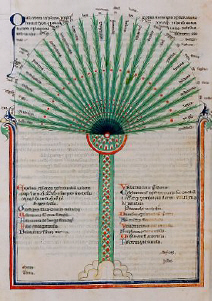11. The very heavens, patently multiple, cannot be thought to disdain any form of life since this universe holds everything. Now how do these things come to be here? Does the higher realm contain all of the lower?
All that has been shaped by Reason-Principle and conforms to Idea.
But, having fire (warmth) and water, it will certainly have vegetation; how does vegetation exist There? Earth, too? either these are alive or they are There as dead things and then not everything There has life. How in sum can the things of this realm be also There?
Vegetal life we can well admit, for the plant is a Reason-Principle established in life. If in the plant the Reason-Principle, entering Matter and constituting the plant, is a certain form of life, a definite soul, then, since every Reason-Principle is a unity, then either this of plant-life is the primal or before it there is a primal plant, source of its being: that first plant would be a unity; those here, being multiple, must derive from a unity. This being so, that primal must have much the truer life and be the veritable plant, the plants here deriving from it in the secondary and tertiary degree and living by a vestige of its life.
But earth; how is there earth There: what is the being of earth and how are we to represent to ourselves the living earth of that realm?
First, what is it, what the mode of its being?
Earth, here and There alike, must possess shape and a Reason-Principle. Now in the case of the vegetal, the Reason-Principle of the plant here was found to be living in that higher realm: is there such a Reason-Principle in our earth?
Take the most earthy of things found shaped in earth and they exhibit, even they, the indwelling earth-principle. The growing and shaping of stones, the internal moulding of mountains as they rise, reveal the working of an ensouled Reason-Principle fashioning them from within and bringing them to that shape: this, we must take it, is the creative earth-principle corresponding to what we call the specific principle of a tree; what we know as earth is like the wood of the tree; to cut out a stone is like lopping a twig from a tree, except of course that there is no hurt done, the stone remaining a member of the earth as the twig, uncut, of the tree.
Realizing thus that the creative force inherent in our earth is life within a Reason-Principle, we are easily convinced that the earth There is much more primally alive, that it is a reasoned Earth-Livingness, the earth of Real-Being, earth primally, the source of ours.
Fire, similarly, with other such things, must be a Reason-Principle established in Matter: fire certainly does not originate in the friction to which it may be traced; the friction merely brings out a fire already existent in the scheme and contained in the materials rubbed together. Matter does not in its own character possess this fire-power: the true cause is something informing the Matter, that is to say, a Reason-Principle, obviously therefore a soul having the power of bringing fire into being; that is, a life and a Reason-Principle in one.
It is with this in mind that Plato says there is soul in everything of this sphere. That soul is the cause of the fire of the sense-world; the cause of fire here is a certain Life of fiery character, the more authentic fire. That transcendent fire being more truly fire will be more veritably alive; the fire absolute possesses life. And the same principles apply to the other elements, water and air.
Why, then, are water and air not ensouled as earth is?
Now, it is quite certain that these are equally within the living total, parts of the living all; life does not appear visibly in them; but neither does it in the case of the earth where its presence is inferred by what earth produces: but there are living things in fire and still more manifestly in water and there are systems of life in the air. The particular fire, rising only to be quenched, eludes the soul animating the universe; it slips away from the magnitude which would manifest the soul within it; so with air and water. If these Kinds could somehow be fastened down to magnitude they would exhibit the soul within them, now concealed by the fact that their function requires them to be loose or flowing. It is much as in the case of the fluids within ourselves; the flesh and all that is formed out of the blood into flesh show the soul within, but the blood itself, not bringing us any sensation, seems not to have soul; yet it must; the blood is not subject to blind force; its nature obliges it to abstain from the soul which nonetheless is indwelling in it. This must be the case with the three elements; it is the fact that the living beings formed from the close conglomeration of air (the stars) are not susceptible to suffering. But just as air, so long as it remains itself, eludes the light which is and remains unyielding, so too, by the effect of its circular movement, it eludes soul – and, in another sense, does not. And so with fire and water.
